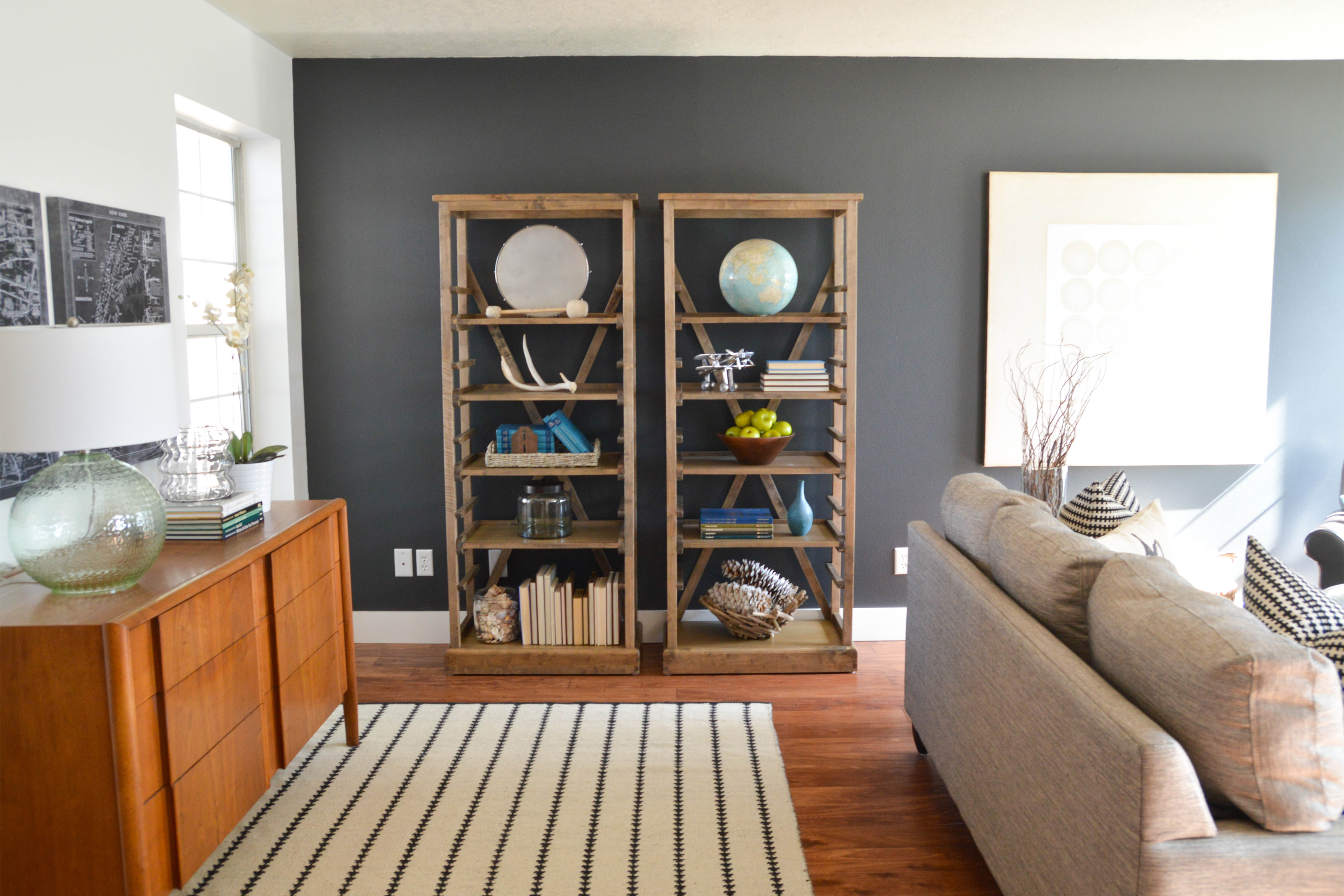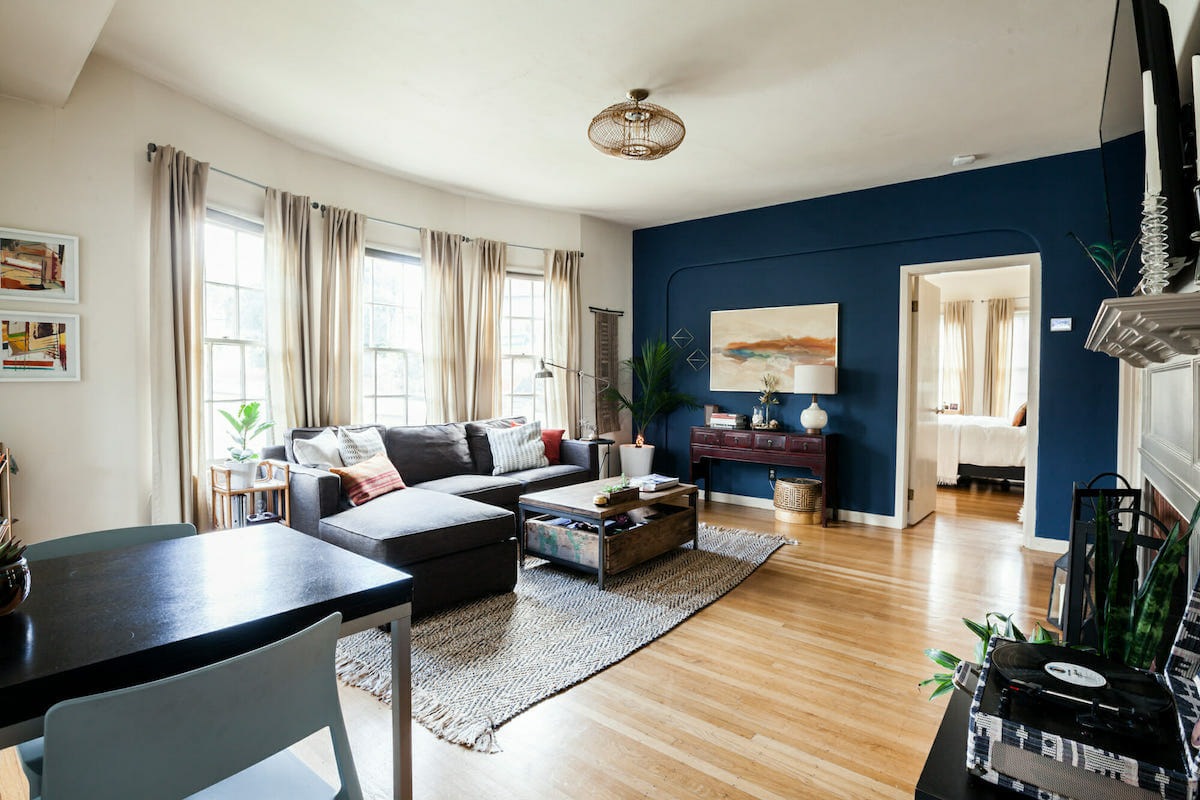Introduction
How To Pick Accent Wall Color: In the realm of interior design, selecting an accent wall color is akin to choosing a brushstroke that transforms a blank canvas into a captivating masterpiece. The accent wall serves as a focal point, injecting personality, depth, and visual interest into a room’s ambiance. This guide is your compass in the captivating journey of choosing the ideal accent wall color – a choice that can shape the entire aesthetic of your living space.
Gone are the days when walls were merely boundaries; they now tell stories and set moods. Picking the right accent color involves a delicate dance between understanding color theory, considering the room’s purpose, and aligning with your personal style. Each color holds an emotional and psychological impact, and harnessing this power can create a dynamic and harmonious environment.
From calming blues to energetic reds, subdued neutrals to daring metallics, the options are vast and varied. This guide delves into the nuances of color psychology, helping you understand the emotions that different hues evoke. It provides insights into the interplay of natural and artificial light, which can dramatically alter how a color appears in a space.
Selecting an accent wall color isn’t just about aesthetics; it’s about the art of curating an environment that resonates with you and enhances your daily life. Whether you’re aiming to create a cozy retreat or a vibrant statement, this guide equips you with the knowledge and inspiration to navigate the palette of possibilities and confidently choose the accent wall color that speaks to your soul.

What color should an accent wall be?
A lighter accent wall is more likely to open up the space, and a darker color is more likely to either draw your attention or make something recede into the background depending on what’s being painted.
Choosing the right color for an accent wall depends on several factors, including the room’s purpose, existing color scheme, and personal preferences. An accent wall is meant to create visual interest and contrast within a space, so it should complement the overall design while making a statement.
Consider the room’s atmosphere: Warm tones like deep reds, oranges, or rich yellows can create a cozy and inviting feel, while cooler shades like blues or greens can evoke a sense of calmness.
Harmonize with existing colors: Look at the room’s current color palette and choose a shade that complements the dominant colors. This could involve selecting a color from a piece of furniture, artwork, or décor.
Bold or subtle: Decide whether you want the accent wall to be a focal point or a more subdued addition. Bold colors like deep navy or vibrant emerald can create a striking contrast, while softer hues like muted pastels can provide a subtle touch of distinction.
Room size and lighting: Lighter colors can make a small room feel more spacious, while darker shades can add coziness to a larger space. Consider the room’s natural and artificial lighting, as it can affect how the color appears.
Personal taste: Ultimately, the color should resonate with your personal style and preferences. Think about colors that make you feel comfortable and happy.
Samples and testing: Before committing to a color, get paint samples and test them on a small portion of the wall. See how they look under different lighting conditions and alongside the room’s furnishings.
Should an accent wall be lighter or darker?
Ultimately, the color of the accent wall should complement the existing design elements in the room. It really depends on the size of the room and the look that you are going for. Generally, a lighter shade on an accent wall will make a space look larger, while a darker one will make it look cozier.
Whether an accent wall should be lighter or darker depends on the desired effect you want to achieve in the room. Both options can work effectively, but the choice should be guided by the room’s size, lighting, existing color palette, and the mood you want to create.
Lighter Accent Wall: Lighter accent walls can make a room feel more spacious and open, which is particularly beneficial for smaller rooms. Light colors reflect more light, which can help brighten up the space and create an airy atmosphere. If the room lacks natural light or feels cramped, a lighter accent wall can help alleviate these issues.
Darker Accent Wall: Darker accent walls can create a cozy and intimate ambiance, making larger rooms feel more inviting and snug. Dark colors absorb light, so they can lend a sense of warmth and comfort to a space. If the room already receives plenty of natural light or has a predominantly light color scheme, a darker accent wall can add depth and contrast.
How many walls should you paint as an accent color?
We recommend sticking to one accent wall per room. Picking two or three will dilute the effect; the room will feel like a collage of colours rather than a carefully designed palette.
Typically, one wall is painted as an accent color in a room. This approach provides a focal point and visual interest without overwhelming the space. The accent wall is strategically chosen to draw attention to a specific area, architectural feature, or piece of furniture. This technique works well in various rooms, from living rooms to bedrooms, and adds a touch of personality to the design.
However, there are cases where painting more than one wall as an accent can be effective. For instance, in larger rooms with multiple seating areas, two adjacent walls could be painted to create a cohesive look. Just be cautious not to create too much contrast that overwhelms the space.
In rooms with unique architecture or alcoves, painting multiple walls can highlight these features. It’s essential to ensure that the colors you choose work well together and that the room’s overall balance isn’t compromised.
Remember, the goal of accent walls is to enhance the room’s aesthetics and create visual interest. Whether you opt for one or more accent walls, the decision should align with your design goals and the room’s layout to achieve a harmonious and appealing result.
What color accent wall makes a room look bigger?
When considering colors that make a room look bigger, white, in its many shades, is always an optimum choice. Its reflective qualities help to open a space and make it appear light and airy.
Light and neutral colors are generally the best choices for creating the illusion of a larger room. Shades like soft whites, pale creams, light grays, and pastels can make a room appear more spacious and open. These colors reflect more light, creating an airy and expansive feel.
White or off-white accent walls are particularly effective as they bounce light around the room, making it feel brighter and more open. Light gray tones can add depth without making the room feel heavy, while pastels like light blue or pale green can bring a sense of calmness and space.
Additionally, choosing a color that is slightly lighter than the other walls in the room can create a subtle contrast that adds dimension without making the space feel confined. Consider using the same color family as the other walls but opting for a lighter shade for the accent wall.
When creating the illusion of a larger room, it’s not only about the color of the accent wall but also how it interacts with the overall color scheme, lighting, and furniture placement. Combining a light accent wall with proper lighting, strategically placed mirrors, and minimalistic furniture arrangements can collectively contribute to a visually expanded space.

What role does color psychology play in choosing an accent wall color?
Color psychology plays a profound role in the process of selecting an accent wall color, as it delves into the intricate relationship between colors and human emotions. The colors we surround ourselves with can significantly impact our mood, behavior, and even cognitive responses. When choosing an accent wall color, understanding these psychological associations allows you to create an environment that resonates with the desired atmosphere.
For instance, warm hues like reds and oranges are often associated with energy, passion, and vitality. They can be excellent choices for accent walls in areas where social interaction and stimulation are desired, such as living rooms or dining spaces. In contrast, cool shades like blues and greens evoke calmness, tranquility, and relaxation, making them suitable for bedrooms or spaces where serenity is prioritized.
Moreover, color can influence the perceived size and mood of a room. Darker tones can add depth and intimacy, making larger spaces feel cozier, while lighter tones create an illusion of spaciousness. These nuances of color psychology guide your decision-making, allowing you to manipulate the visual impact of a room through your chosen accent wall color.
Color psychology enables you to harness the emotional power of colors to achieve specific goals. By aligning your accent wall color with the mood and ambiance you want to create, you can design a space that not only appeals aesthetically but also emotionally resonates with both residents and visitors. It’s a tool that empowers you to curate an environment that reflects your intentions and enriches the experience of the space.
How does natural and artificial light influence the appearance of accent wall colors?
Natural and artificial light play a pivotal role in how accent wall colors are perceived within a space. These sources of light interact with the chosen color, altering its hue, intensity, and overall ambiance. Understanding this interplay is crucial when selecting an accent wall color to ensure the desired visual effect.
Natural light, with its changing qualities throughout the day, can significantly impact how a color appears. Cooler colors may appear more vivid in bright natural light, while warmer colors can seem subdued during certain times. Sunlight also brings out the true undertones of colors, highlighting subtle nuances that might be less noticeable under artificial light.
Artificial lighting, on the other hand, can introduce its own color temperature. Warm incandescent lights can enhance warm-toned colors, while cooler LED lights might emphasize cooler tones. This shift in color temperature can alter the overall mood of the space and how the accent wall color interacts with other elements.
To make an informed decision about an accent wall color, it’s crucial to consider the type of lighting the room receives. This involves observing the room’s lighting conditions at different times of the day and under various lighting sources. It’s also advisable to test paint swatches directly on the wall and observe how they appear under different lighting conditions.
What factors should I consider when selecting an accent wall color for a specific room?
When choosing an accent wall color for a specific room, several crucial factors come into play to ensure a harmonious and impactful design. Firstly, consider the room’s purpose and desired ambiance. Different colors evoke distinct emotions, so select a hue that aligns with the room’s intended function – calming shades for bedrooms and invigorating tones for social spaces.
Secondly, examine the room’s existing decor and furniture. The chosen color should complement and enhance the overall aesthetic, creating a cohesive and visually pleasing environment. Take note of the dominant colors in the furnishings and artwork; choosing an accent color that echoes or contrasts these elements can create an engaging visual balance.
Another critical consideration is the room’s size and layout. Darker colors can add coziness to spacious rooms, while light shades can make smaller spaces appear larger. The room’s lighting conditions, both natural and artificial, also influence how the color will appear. Test paint samples under different lighting sources to ensure the color maintains its intended effect.
Furthermore, assess the room’s architectural features. An accent wall color can emphasize architectural details such as alcoves, niches, or molding. Conversely, it can minimize less desirable elements. Lastly, let your personal style shine. The chosen accent wall color should resonate with your tastes and preferences while harmonizing with the rest of your home’s color palette.
The factors to consider when selecting an accent wall color encompass the room’s purpose, existing decor, size, lighting, architectural features, and your individual style. Balancing these elements ensures that the chosen color not only enhances the room’s aesthetics but also creates a functional and emotionally resonant space.
What are some popular accent wall color options for creating a cozy atmosphere?
Creating a cozy atmosphere in a room often involves selecting accent wall colors that evoke warmth, comfort, and a sense of relaxation. Here are some popular accent wall color options that can help you achieve that cozy ambiance:
Earthy Neutrals: Earthy tones like warm beige, soft taupe, or gentle gray create a soothing and grounded atmosphere. They work well in living rooms and bedrooms, providing a neutral backdrop for cozy furnishings and decor.
Deep Blues: Rich, deep blues, reminiscent of the night sky, can instill a sense of calm and serenity. These hues are ideal for bedrooms or spaces where you want to create a cocooning effect.
Muted Greens: Soft greens, such as sage or olive, offer a connection to nature and bring a tranquil, organic feel to a room. They work wonders in bedrooms, home offices, or reading nooks.
Warm Reds: Deep reds, terracottas, or brick tones can infuse a space with warmth and comfort. These colors are well-suited for dining areas or gathering spaces, as they stimulate conversation and connection.
Cozy Browns: Rich chocolate browns or warm caramel shades can envelop a room in coziness. These earthy tones are perfect for creating a warm and inviting living room or den.
Soft Grays: Subtle, warm grays create a sense of understated elegance and coziness. They’re versatile and can be used in various rooms, from bedrooms to home offices.
Dark Charcoals: Deep, dark charcoal grays or blacks can create a sense of intimacy and coziness, especially in larger spaces. They work well in bedrooms, home theaters, or dining areas.
When choosing a cozy accent wall color, consider the room’s existing decor, lighting, and your personal preferences. These popular colors can serve as a starting point to create a warm and inviting atmosphere that makes you feel right at home.

Conclusion
In the intricate tapestry of interior design, the art of selecting an accent wall color serves as a pivotal brushstroke that weaves emotion, style, and functionality into the fabric of your living space. The journey to choosing the perfect hue transcends the mere act of decorating; it becomes an expression of your personality, a reflection of your intentions, and a conduit for transforming rooms into havens of comfort and creativity.
Color psychology unveils the profound impact that different hues have on our emotions, allowing you to curate spaces that elicit the desired feelings. The dance between natural and artificial light teaches you the importance of adaptability, ensuring that your chosen color remains consistent in various lighting conditions. A multitude of factors, from a room’s purpose to its size and existing decor, merge to guide your selection, facilitating an environment that harmonizes aesthetics and function.
The journey to picking an accent wall color is a symphony of considerations. It’s a journey that involves delving into your preferences, understanding the psychology of color, and sculpting spaces that cocoon you in comfort or invigorate with energy. As you embark on this creative odyssey, remember that the colors you choose are more than mere pigments; they are the palette with which you paint the canvas of your surroundings, infusing each room with personality, mood, and the artistry of your vision.


